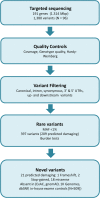A targeted sequencing panel identifies rare damaging variants in multiple genes in the cranial neural tube defect, anencephaly
- PMID: 29205322
- PMCID: PMC5887939
- DOI: 10.1111/cge.13189
A targeted sequencing panel identifies rare damaging variants in multiple genes in the cranial neural tube defect, anencephaly
Abstract
Neural tube defects (NTDs) affecting the brain (anencephaly) are lethal before or at birth, whereas lower spinal defects (spina bifida) may lead to lifelong neurological handicap. Collectively, NTDs rank among the most common birth defects worldwide. This study focuses on anencephaly, which despite having a similar frequency to spina bifida and being the most common type of NTD observed in mouse models, has had more limited inclusion in genetic studies. A genetic influence is strongly implicated in determining risk of NTDs and a molecular diagnosis is of fundamental importance to families both in terms of understanding the origin of the condition and for managing future pregnancies. Here we used a custom panel of 191 NTD candidate genes to screen 90 patients with cranial NTDs (n = 85 anencephaly and n = 5 craniorachischisis) with a targeted exome sequencing platform. After filtering and comparing to our in-house control exome database (N = 509), we identified 397 rare variants (minor allele frequency, MAF < 1%), 21 of which were previously unreported and predicted damaging. This included 1 frameshift (PDGFRA), 2 stop-gained (MAT1A; NOS2) and 18 missense variations. Together with evidence for oligogenic inheritance, this study provides new information on the possible genetic causation of anencephaly.
Keywords: anencephaly; craniorachischisis; molecular diagnosis; neural tube defects; targeted exome sequencing.
© 2017 The Authors. Clinical Genetics published by John Wiley & Sons A/S. Published by John Wiley & Sons Ltd.
Conflict of interest statement
The authors declare that they have no conflict of interest.
Figures


References
-
- Doudney K, Grinham J, Whittaker J, et al. Evaluation of folate metabolism gene polymorphisms as risk factors for open and closed neural tube defects. Am J Med Genet A. 2009;149A:1585‐1589. - PubMed
-
- Leck I. Causation of neural tube defects: clues from epidemiology. Br Med Bull. 1974;30:158‐163. - PubMed
-
- Harris MJ, Juriloff DM. An update to the list of mouse mutants with neural tube closure defects and advances toward a complete genetic perspective of neural tube closure. Birth Defects Res A Clin Mol Teratol. 2010;88:653‐669. - PubMed
-
- MRC Vitamin Study Research Group . Prevention of neural tube defects: results of the Medical Research Council Vitamin Study. Lancet. 1991;338:131‐137. - PubMed
Publication types
MeSH terms
Grants and funding
LinkOut - more resources
Full Text Sources
Other Literature Sources
Medical
Miscellaneous

